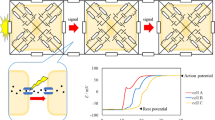Abstract.
The superficial (tonic) abdominal flexor muscles of Atya lanipes do not generate Ca2+ action potentials when depolarized and have no detectable inward Ca2+ current. These fibers, however, are strictly dependent on Ca2+ influx for contraction, suggesting that they depend on Ca2+-induced Ca2+ release for contractile activation. The nature of the communication between Ca2+ channels in the sarcolemmal/tubular membrane and Ca2+ release channels in the sarcoplasmic reticulum in this crustacean muscle was investigated. The effects of dihydropyridines on tension generation and the passive electrical response were examined in current-clamped fibers: Bay K 8644 enhanced tension about 100% but did not alter the passive electrical response; nifedipine inhibited tension by about 70%. Sr2+ and Ba2+ action potentials could be elicited in Ca2+-free solutions. The spikes generated by these divalent cations were abolished by nifedipine. As the Sr2+ or Ba2+ concentrations were increased, the amplitudes of the action potentials and their maximum rate of rise, V max , increased and tended towards saturation. Three-microelectrode voltage-clamp experiments showed that even at high (138 mm) extracellular Ca2+ concentration the channels were silent, i.e., no inward Ca2+ current was detected. In Ca2+-free solutions, inward currents carried by 138 mm Sr2+ or Ba2+ were observed. The currents activated at voltages above −40 mV and peaked at about 0 mV. This voltage-activation profile and the sensitivity of the channels to dihydropyridines indicate that they resemble L-type Ca2+ channels. Peak inward current density values were low, ca.−33 μA/cm2 for Sr2+ and −14 μA/cm2 for Ba2+, suggesting that Ca2+ channels are present at a very low density. It is concluded that Ca2+-induced Ca2+ release in this crustacean muscle operates with an unusually high gain: Ca2+ influx through the silent Ca2+ channels is too low to generate a macroscopic inward current, but increases sufficiently the local concentration of Ca2+ in the immediate vicinity of the sarcoplasmic reticulum Ca2+ release channels to trigger the highly amplified release of Ca2+ required for tension generation.
Similar content being viewed by others
Author information
Authors and Affiliations
Additional information
Received: 5 April 1999/Revised: 15 September 1999
Rights and permissions
About this article
Cite this article
Monterrubio, J., Lizardi, L. & Zuazaga, C. Silent Calcium Channels in Skeletal Muscle Fibers of the Crustacean Atya lanipes . J. Membrane Biol. 173, 9–17 (2000). https://doi.org/10.1007/s002320001002
Issue Date:
DOI: https://doi.org/10.1007/s002320001002




